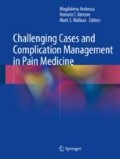Abstract
Opioid overdose has reached epidemic levels secondary to the increase use of prescription opioids and increased use of heroin in the United States. Most overdoses include multiple sedatives, and each overdose presents with respiratory depression. Naloxone, titrated to restore respiration but not to complete reversal, is the antidote of choice. Because naloxone has a half-life shorter than most opioids, return of respiratory depression frequently occurs after initial improvement, thus making repeat doses or infusions necessary. Risk factors for overdose include total dose, recent increase in dose, age, pulmonary, liver or kidney disease, sleep apnea, the use of other sedatives, substance abuse, and prior overdose.
Access this chapter
Tax calculation will be finalised at checkout
Purchases are for personal use only
References
CDC Health Alert Network October 26, 2015, 0815 EDT (08:15 AM EDT) CDCHAN-00384. http:// http://emergency.cdc.gov/han/han00384.asp. Accessed 10 July 2016.
Dunn KM, Saunders KW, Rutter CM, et al. Opioid prescriptions for chronic pain and overdose: a cohort study. Ann Intern Med. 2010;152(2):85–92.
Paulozzi LJ, Kilbourne EM, Shah NG, et al. A history of being prescribed controlled substances and risk of drug overdose death. Pain Med. 2012;13(1):87–95.
Boyer EW. Management of opioid analgesic overdose. N Engl J Med. 2012;367(2):146–55.
Gomes T, Mamdani MM, Dhalla IA, Paterson JM, Juurlink DN. Opioid dose and drug-related mortality in patients with nonmalignant pain. Arch Intern Med. 2011;171(7):686–91.
Bohnert AS, Valenstein M, Bair MJ, et al. Association between opioid prescribing patterns and opioid overdose-related deaths. JAMA. 2011;305(13):1315–21.
Dasgupta N, Funk MJ, Proescholdbell S, Hirsch A, Ribisl KM, Marshall S. Cohort study of the impact of high-dose opioid analgesics on overdose mortality [published online September 1, 2015]. Pain Med. doi:10.1111/pme.12907.
Sivilotti ML. Flumazenil, naloxone and the ‘coma cocktail’. Br J Clin Pharmacol. 2016;81(3):428–36. Epub 21 Sept 2015.
Gwira Baumblatt JA, Wiedeman C, Dunn JR, Schaffner W, Paulozzi LJ, Jones TF. High-risk use by patients prescribed opioids for pain and its role in overdose deaths. JAMA Intern Med. 2014;174(5):796–801.
Liang Y, Turner BJ. Assessing risk for drug overdose in a national cohort: role for both daily and total opioid dose? J Pain. 2015;16(4):318–25.
Zedler B, Xie L, Wang L, et al. Risk factors for serious prescription opioid-related toxicity or overdose among Veterans Health Administration patients. Pain Med. 2014;15(11):1911–29.
White JM, Irvine RJ. Mechanisms of fatal opioid overdose. Addiction. 1999;94(7):961–72.
Siegel S. Pavlovian conditioning and heroin overdose: reports by overdose victims. Bull Psychon Soc. 1984;22(5):428–30.
Bohnert AS, Logan JE, Ganoczy D, Dowell D. A detailed exploration into the association of prescribed opioid dosage and overdose deaths among patients with chronic pain [published online January 22, 2016]. Med Care. doi:10.1097/MLR.0000000000000505.
Author information
Authors and Affiliations
Corresponding author
Editor information
Editors and Affiliations
Rights and permissions
Copyright information
© 2018 Springer International Publishing AG
About this chapter
Cite this chapter
Polston, G. (2018). Opioid Overdose. In: Anitescu, M., Benzon, H., Wallace, M. (eds) Challenging Cases and Complication Management in Pain Medicine. Springer, Cham. https://doi.org/10.1007/978-3-319-60072-7_1
Download citation
DOI: https://doi.org/10.1007/978-3-319-60072-7_1
Published:
Publisher Name: Springer, Cham
Print ISBN: 978-3-319-60070-3
Online ISBN: 978-3-319-60072-7
eBook Packages: MedicineMedicine (R0)

